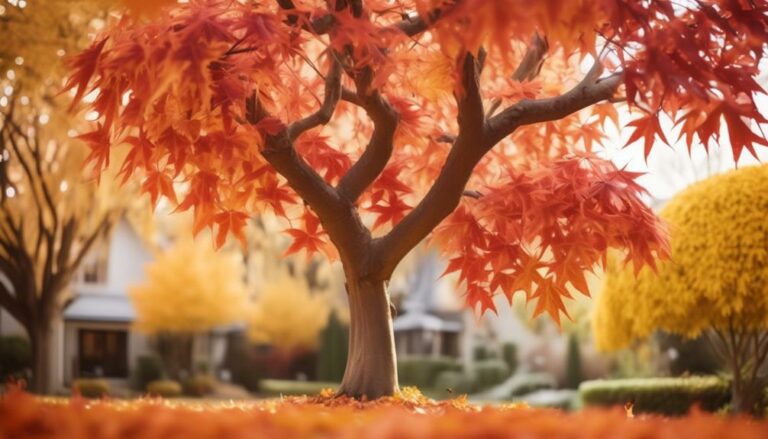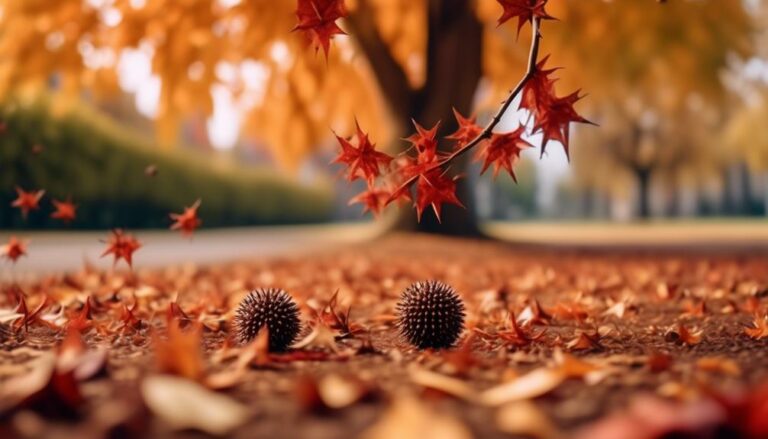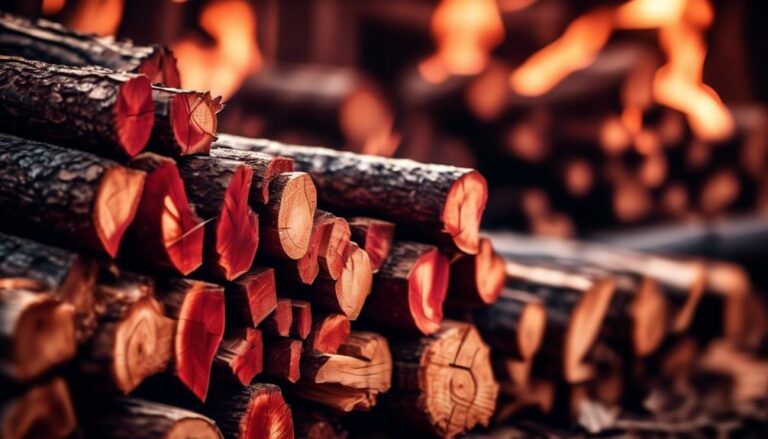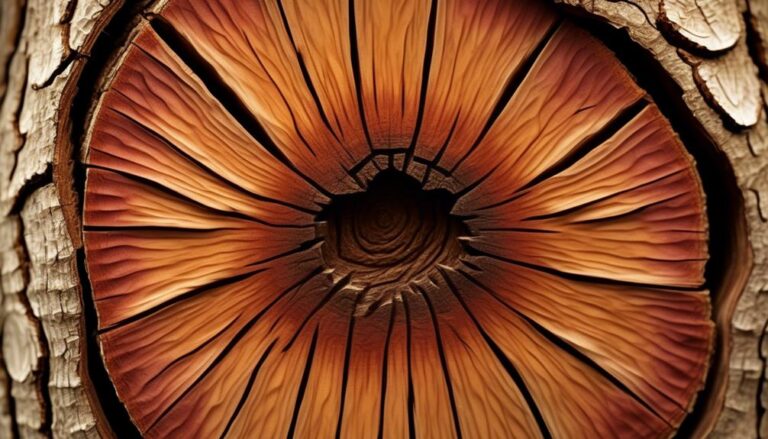Creating Wildlife Habitats With Liquidambar Trees
You may be wondering if planting Liquidambar trees in your landscape is worth the effort. Well, let me assure you that creating wildlife habitats with these trees is not only beneficial but also incredibly rewarding.
Liquidambar trees, also known as Sweetgum trees, offer a host of advantages for wildlife. They attract a diverse range of bird species, provide food and shelter for small mammals, and even serve as hosts for butterflies.
In this discussion, we will explore the various ways in which Liquidambar trees contribute to biodiversity and ecological balance, leaving you with a newfound appreciation for these remarkable trees and a desire to learn more.
Benefits of Liquidambar Trees for Wildlife
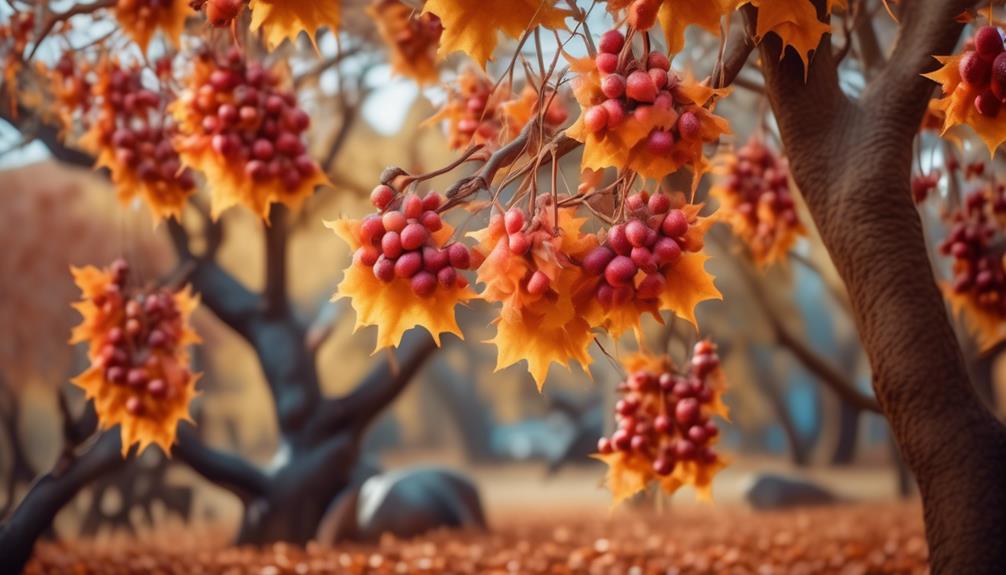
Liquidambar trees offer numerous benefits for wildlife, supporting a diverse range of species and contributing to local biodiversity.
One of the key advantages of these trees is their role as a larval host for over thirty butterfly species. The sweetgum tree provides a vital habitat for the growth and development of these butterflies, ensuring their survival and contributing to the overall ecological balance.
Additionally, the seeds and flowers of the sweetgum tree serve as an important food source for birds like goldfinches and mallard ducks.
By planting liquidambar trees in your landscape, you can create a welcoming environment for wildlife, promoting the health and diversity of local ecosystems.
Consider incorporating liquidambar trees into your habitat to support a wide array of species and enhance the overall biodiversity of your surroundings.
Attracting Birds With Liquidambar Trees
To attract birds to your landscape, consider planting Liquidambar trees. These trees offer bird-friendly features, such as seed balls that can be transformed into bird feeders.
Bird-Friendly Tree Features
Attract a diverse range of bird species to your garden with the bird-friendly features of liquidambar trees. These trees are known for attracting various bird species, including goldfinches, mallard ducks, and hummingbirds. The seeds and flowers of liquidambar trees serve as a food source for these birds, making them a valuable addition to any garden.
Additionally, the seed balls of sweetgum trees can be used to create bird feeders by filling them with peanut butter, providing a sustainable food source for birds.
Liquidambar trees also play a role in supporting wildlife by serving as larval hosts for over thirty butterfly species, such as the Promethea moth and Luna moth.
These trees are adaptable and thrive in various climates, making them an ideal choice for supporting bird populations in diverse habitats.
Liquidambar Tree Benefits
By incorporating liquidambar trees into your garden, you can create a wildlife-friendly habitat that attracts a diverse range of bird species. Here are some benefits of liquidambar trees for attracting birds:
- Liquidambar trees support a variety of wildlife, including small mammals like gray squirrels, beavers, and chipmunks.
- Numerous bird species, such as goldfinches, mallard ducks, and hummingbirds, feed on the sweetgum seeds and flowers.
- Sweetgum trees serve as larval hosts for over thirty species of butterflies, including the Promethea moth and Luna moth.
- The seed balls of sweetgum trees can be used to make bird feeders by filling them with peanut butter.
- Growing liquidambar styraciflua in your landscape can contribute to the biodiversity and ecological balance of your surroundings.
Creating Nesting Opportunities With Liquidambar Trees
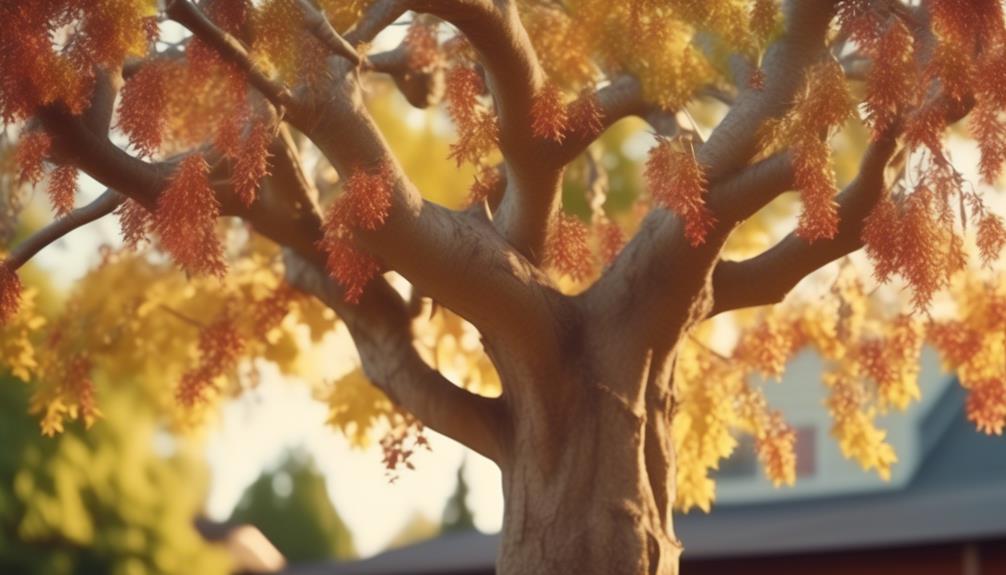
Liquidambar trees offer nesting sites for birds, providing a safe and secure place for them to raise their young.
The tree cavities created by these trees can also serve as ideal homes for a variety of wildlife, such as squirrels, raccoons, and other small mammals.
Nesting Sites for Birds
With their dense foliage and sturdy branches, liquidambar trees provide ideal nesting sites for various bird species. The spiky fruit capsules of sweetgum trees can serve as protective cover and nesting material for birds. Liquidambar trees' adaptable nature makes them suitable for creating diverse nesting habitats for birds in different climates. Planting liquidambar trees in landscapes can contribute to biodiversity and ecological balance, attracting birds to nest and thrive. Sweetgum trees support a variety of wildlife, including numerous bird species, which find nesting opportunities in their branches and foliage. Female flowers on liquidambar trees provide a source of nectar for birds, further attracting them to nest in these trees.
Tree Cavities for Wildlife
For wildlife seeking nesting opportunities, the tree cavities found in liquidambar trees offer essential shelter and breeding spaces. These cavities serve as crucial nesting sites for various wildlife species, including birds, mammals, and other creatures.
In the southeastern United States, liquidambar trees attract a diverse range of cavity-nesting bird species, such as woodpeckers, chickadees, and owls. By creating and preserving tree cavities in liquidambar trees, we can contribute to the biodiversity and ecological balance of our surrounding habitats.
These tree cavities play a vital role in supporting wildlife populations by providing essential nesting and sheltering spaces. By ensuring the availability of these cavities, we can help sustain and protect the diverse wildlife species that rely on them for survival and reproduction.
Habitat Enrichment Opportunities
Enhance your local habitat by creating nesting opportunities with the use of liquidambar trees. These trees not only provide beauty with their stunning fall foliage, but they also offer valuable nesting sites for a variety of wildlife.
Here are some ways to maximize the nesting potential of liquidambar trees:
- Leave dead branches or create snags: Dead branches or standing dead trees provide natural cavities for birds and small mammals to nest in.
- Install nest boxes: Place nest boxes for cavity-nesting birds in the trees to attract species like chickadees, woodpeckers, and bluebirds.
- Provide nesting materials: Scatter natural materials such as twigs, leaves, and grass around the base of the tree to offer building materials for bird nests.
- Create brush piles: Stack branches and twigs near the tree to create hiding spots and shelter for ground-dwelling birds and small mammals.
- Reduce insect pests: Liquidambar trees attract insects, which can be a food source for birds. Avoid using pesticides to preserve this natural food supply.
Providing Food Sources for Wildlife With Liquidambar Trees
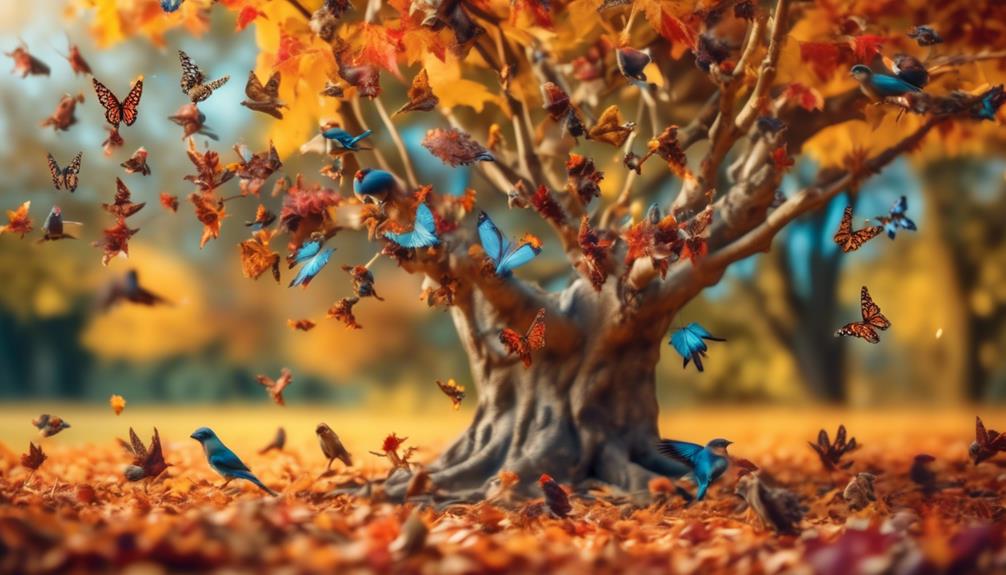
By attracting various bird species and serving as larval hosts for butterflies, liquidambar trees provide valuable food sources for wildlife.
The inconspicuous flowers of the liquidambar tree produce nectar that attracts a variety of birds, including goldfinches, mallard ducks, and hummingbirds. These birds feed on the nectar, helping to pollinate the trees in the process.
Additionally, liquidambar trees produce spiny fruits known as sweetgum balls. Crafters and decorators often use these dried fruit capsules in wreaths and other arrangements. However, these fruits also serve as a food source for wildlife. The seed balls can be used to make bird feeders by filling them with peanut butter, attracting birds and supporting their nutritional needs.
Shelter and Protection Offered by Liquidambar Trees
As we shift our focus to the shelter and protection offered by liquidambar trees, it's important to highlight how these majestic trees create a safe haven for a diverse range of wildlife.
The tree, liquidambar styraciflua, provides shelter and protection in the following ways:
- Small mammals like squirrels, beavers, and chipmunks find refuge in the branches and hollows of liquidambar trees.
- Various bird species, including goldfinches, mallard ducks, and hummingbirds, seek shelter and protection in these trees, while also feeding on their seeds and flowers.
- Liquidambar trees serve as larval hosts for over thirty species of butterflies, such as the Promethea moth and Luna moth, providing protection and habitat for these insects.
- The seed balls of liquidambar trees can be used to create bird feeders, offering shelter and nourishment to birds in the surrounding habitat.
- By growing liquidambar styraciflua in your landscape, you contribute to overall biodiversity and ecological balance, providing shelter and protection to various organisms.
Liquidambar trees truly play a vital role in creating a thriving ecosystem, offering shelter and protection to a wide array of wildlife.
Liquidambar Trees as Habitat for Squirrels and Other Small Mammals

Liquidambar trees, also known as sweetgum trees, provide valuable shelter for small mammals like squirrels and chipmunks. These trees offer a safe and secure habitat for these animals, allowing them to find refuge from predators and harsh weather conditions.
Additionally, sweetgum trees produce seeds and flowers that serve as a food source for squirrels, further supporting their presence in the ecosystem.
Shelter for Small Mammals
Sweetgum trees provide essential shelter for small mammals like squirrels and chipmunks, creating an ideal habitat for their protection and survival. Here are some key reasons why these trees are important shelters for small mammals:
- The spiny fruits of sweetgum trees offer nesting and hiding places for small mammals, enhancing their habitat.
- The dense foliage and branching structure of sweetgum trees provide protection and shelter for small mammals from predators and the elements.
Sweetgum trees support small mammal populations, creating a diverse and balanced ecosystem within their surroundings.
- Planting Liquidambar styraciflua in your landscape can contribute to the creation of wildlife habitats for small mammals like squirrels and chipmunks.
- The shelter provided by sweetgum trees promotes the survival of small mammals by offering a safe space to rest, hide, and raise their young.
Food Sources for Squirrels
Squirrels and other small mammals find a wealth of food sources within the habitat provided by Liquidambar trees. The Liquidambar tree produces seeds that are highly nutritious and form a significant part of the diet for many wildlife species. Squirrels are particularly fond of these seeds and can often be seen foraging around the base of the tree, collecting and storing them for later consumption. The seeds are rich in fats and proteins, providing squirrels with the energy they need to survive.
In addition to the seeds, Liquidambar trees also attract insects, which serve as an additional food source for squirrels and other small mammals. The abundance of food provided by Liquidambar trees makes them an excellent choice for creating wildlife habitats.
Supporting Butterflies and Pollinators With Liquidambar Trees
By planting Liquidambar trees in your garden, you can create a supportive habitat for a variety of butterflies and pollinators. These magnificent trees have several features that attract and benefit these important creatures:
- Nectar-rich flowers: Liquidambar trees produce clusters of small, inconspicuous flowers that are rich in nectar. Butterflies and other pollinators are attracted to these flowers for their sweet reward.
- Shelter and nesting sites: The dense foliage of Liquidambar trees provides a safe haven for butterflies to rest and seek shelter from predators. Some species of butterflies also lay their eggs on the leaves, creating a suitable environment for their offspring.
- Food source for caterpillars: Certain species of butterflies rely on Liquidambar trees as a host plant for their caterpillars. By planting these trees, you can provide a crucial food source for these caterpillars, ensuring the survival of future butterflies.
- Pollination support: Liquidambar trees attract a wide range of pollinators, including bees and butterflies. As they visit the flowers in search of nectar, they inadvertently transfer pollen from one flower to another, aiding in the tree's reproduction.
- Seasonal interest: Liquidambar trees produce vibrant foliage in the fall, which adds beauty to your garden while also attracting butterflies that feed on the tree's fallen leaves.
Enhancing Biodiversity With Liquidambar Trees
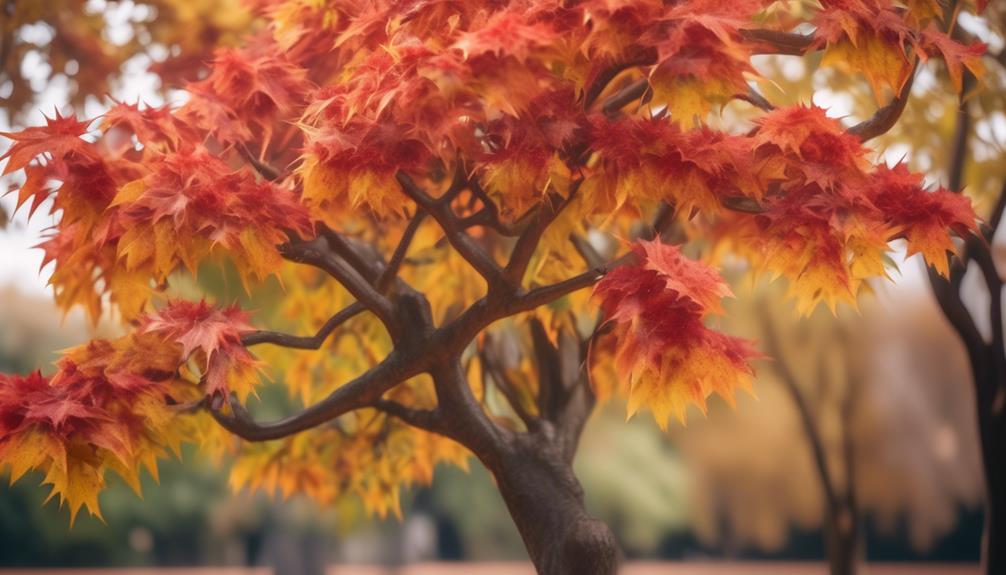
Enhancing biodiversity in your surroundings can be achieved by planting Liquidambar trees, which provide a valuable habitat for various wildlife species.
Liquidambar styraciflua, also known as Sweetgum, is native to the southeastern United States and tropical montane regions of Mexico and Central America. These trees support a diverse range of wildlife, including small mammals, numerous bird species, and over thirty species of butterflies.
By planting Sweetgum trees, you're promoting wildlife support and ecological balance. The spiky fruit capsules of Sweetgum trees can even be used to make bird feeders, further contributing to the enhancement of biodiversity.
These adaptable trees can thrive in a variety of climates and habitats, from humid and subtropical regions to more temperate areas. By growing Liquidambar trees in your landscape, you can create a thriving habitat for various wildlife species and contribute to the overall biodiversity and ecological balance of your surroundings.
Incorporating Liquidambar Trees in Wildlife Garden Designs
Incorporate Liquidambar trees into your wildlife garden designs to create a thriving habitat for various wildlife species. These trees are highly beneficial for wildlife habitats and can enhance the biodiversity in your garden.
Here are five reasons why you should consider incorporating Liquidambar trees in your wildlife garden designs:
- Provides shelter: Liquidambar trees offer excellent shelter for small mammals, birds, and insects, creating a safe and secure environment for them.
- Food source: The tree's seeds and fruits are a valuable food source for a variety of wildlife, attracting birds, squirrels, and other animals to your garden.
- Larval host for butterflies: Liquidambar trees serve as a larval host for over thirty species of butterflies, contributing to the conservation of these beautiful insects.
- Supports pollinators: The flowers of Liquidambar trees attract bees, butterflies, and other pollinators, helping to support their populations and ensure the pollination of other plants in your garden.
- Enhances biodiversity: By incorporating Liquidambar trees, you can increase the overall biodiversity in your wildlife garden, creating a more balanced and vibrant ecosystem.
Maintenance Tips for Creating Wildlife Habitats With Liquidambar Trees

To effectively maintain the health and vitality of Liquidambar trees in your wildlife garden, it's important to implement proper maintenance practices.
Regular pruning is essential to remove dead or damaged branches, ensuring the tree's health and shape.
Additionally, cleaning up fallen gum balls, the spiky fruit capsules, is crucial to prevent clutter and create a safer environment for both wildlife and humans.
Providing supplemental irrigation during dry spells, especially for young Liquidambar trees, will support their growth and development.
Consider mulching around the base of the tree to retain moisture and suppress weed growth, creating a favorable habitat for wildlife.
Lastly, monitor for signs of pests and diseases and take appropriate measures to protect the Liquidambar trees and the wildlife they support.
Following these maintenance tips will help create a thriving wildlife habitat with Liquidambar trees.
Conclusion
In conclusion, planting Liquidambar trees in your landscape can have numerous benefits for wildlife. These trees attract a variety of bird species, provide nesting opportunities, and offer food and shelter for small mammals.
They also support the conservation of butterflies and other pollinators, contributing to biodiversity and ecological balance.
By incorporating Liquidambar trees into your wildlife garden design and properly maintaining them, you can create a thriving habitat for wildlife in your surroundings.


